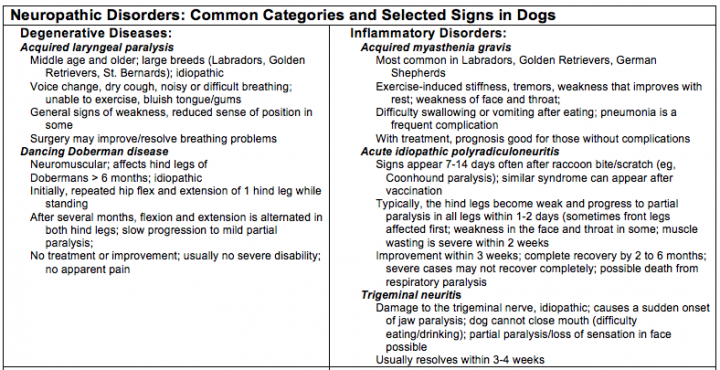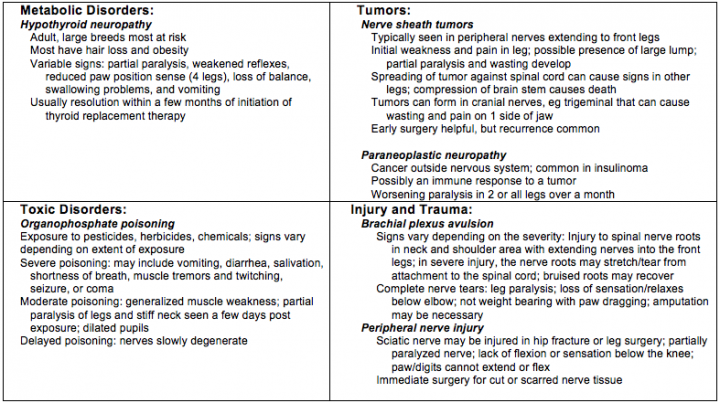Neuropathy in animals can be attributed to a variety of factors including genetics, inflammation, infection, degeneration, trauma, spinal cord disease, toxic disorders, metabolic and nutritional disorders, and cancer / cancer drugs. These factors result in dysfunctions of coordination, digestion, and physical responses. In-depth discussions of the causes and effects of neuropathy may be found throughout veterinary textbooks and literature and in most professional veterinary websites.
The wide variety of types, corresponding signs, and causes (many idiopathic), as well as similarities with other disease signs make the diagnosis very difficult. A thorough history, physical examination, and laboratory testing must be done, usually over several office visits. Unfortunately, the cause of the neuropathy may not be determined and treatment may not cure or stop disease progression.
Clinical Features
Often, signs of disease manifest gradually so many owners assume age-related onset of arthritis as the cause of chronic pain, and many are unaware of the damage and dysfunction that can be caused by neuropathies. Onset of inflammatory neuropathies may be subtle and slow, or they may develop suddenly. Toxicity-associated neuropathies often result in both motor and sensory loss, with weakness, ataxia, loss of muscle mass and tone that manifest subtly and gradually progress. Signs include weakness, ataxia, and loss of muscle mass and tone. Breed-associated neuropathies can be found in several popular dog breeds, for example, Rottweilers, Alaskan Malamutes, Border Collies, Miniature Schnauzers, German Shepherds, Doberman Pinschers, and Labrador Retrievers.

 Table Source: Merck Manual Pet Health. Brain, Spinal Cord, and Nerve Disorders of Dogs. Accessed November 4, 2015.
Table Source: Merck Manual Pet Health. Brain, Spinal Cord, and Nerve Disorders of Dogs. Accessed November 4, 2015.
History, Physical, and Neurologic Evaluation
A complete history provided by the pet owner with direction from the veterinary professional is essential to identify and quantify changes in behavior, neurologic deficits, and any associated pain and its impact on the pet's quality of life. The owner should be taught to look for new, abnormal behaviors that develop with activity or in response to pain and report them to the veterinarian. If the patient has neuropathic pain, the pet owner should be aware that chronic pain management is a long-term process that involves some trial and error and thus changes in treatment.
Read more on Neuropathic Pain and Pain Assessment
It is of foremost importance that the patient - especially one that is experiencing pain - be handled gently in the clinic and at home. Testing will include CBC, blood chemistry, electrolyte panel, urinalysis, and possibly cerebrospinal fluid, and other blood screening to look for / rule out underlying disease. Chest and abdominal radiographs and ultrasound to show cancers and visible neuropathies are also performed.
A neurologic evaluation of the cranial nerves; the gait; neck and front legs and the torso, hind legs, anus, and tail are necessary. Reflex testing to possibly determine the location of the injury in the brain, spinal cord, or peripheral nerves should also be performed.
Electrophysiology studies to determine denervation and nerve conduction velocity are essential, but definitive diagnosis of neuropathy requires a tissue biopsy of peripheral nerves.
Treatment Options
Treatment varies and requires elimination/control of any underlying disease process. For example, dogs with diabetes mellitus require close glucose monitoring and diet adjustment. Treatment selection is based on the type, severity, and duration of pain and can be modified or discontinued based on the patient's response. In-depth discussions of treatment of neuropathies, including integrative care options, are plentiful in the veterinary literature and professional websites.
Read more about Treating Neuropathic Pain - Pharmacologic & Integrative Therapies
View an excerpt of a Roundtable Discussion on modalities and considerations for improving quality of life in dogs and cats with neuropathic pain.